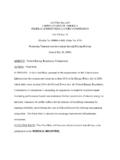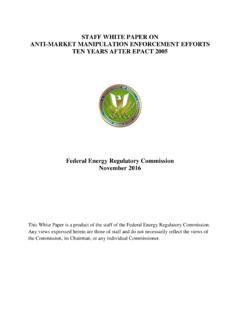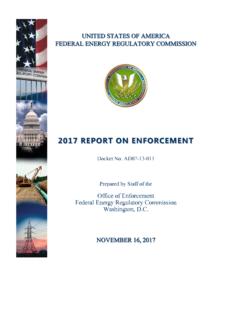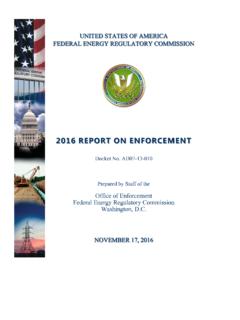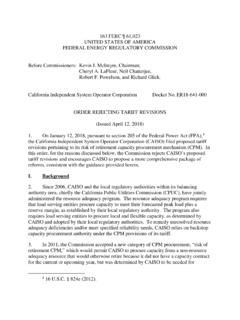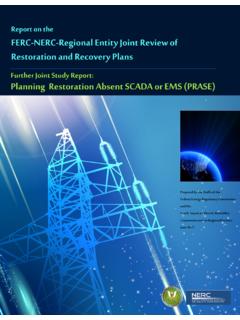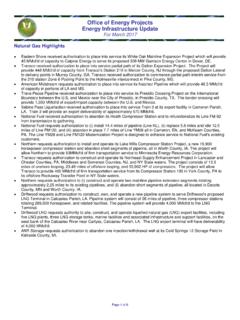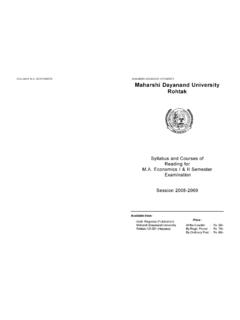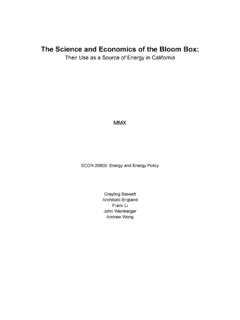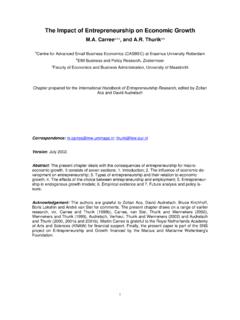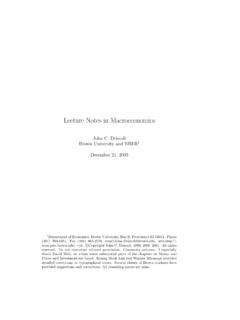Transcription of Price Formation in organized wholesale electricity …
1 Price Formation in organized wholesale electricity Markets Docket No. AD14-14-000 Staff Analysis of Operator Initiated Commitments in RTO and ISO Markets December 2014 For further information, please contact: Emma Nicholson Office of Energy Policy and Innovation Federal Energy Regulatory Commission 888 First Street, NE Washington, DC 20426 (202) 502 8846 This report is a product of the Staff of the Federal Energy Regulatory Commission. The opinions and views expressed in this paper represent the preliminary analysis of the Commission Staff.
2 This report does not necessarily reflect the views of the Commission. Table of Contents Executive Summary .. 1 I. Introduction .. 3 II. Tools Used to Schedule Resources .. 3 A. Security Constrained Unit Commitment .. 5 B. Security Constrained Economic Dispatch .. 8 III. Overview of Resource Scheduling Process .. 8 A. Day-Ahead 10 B. Residual Unit Commitment Schedule .. 14 C. Real-time Schedule .. 18 IV. Locational Marginal Pricing .. 22 A. Locational Marginal Pricing Overview .. 22 B. Cost Elements included in the LMP Framework.
3 25 C. EcoMin Relaxation .. 26 D. Fast-start Pricing Logic in RTOs and ISOs .. 28 V. Empirical Analysis .. 30 A. Methodology .. 31 B. Results Overview .. 32 C. market -specific Results .. 34 VI. Concluding Remarks .. 40 1 Executive Summary This paper is part of an effort to evaluate matters affecting Price Formation in the energy and ancillary services markets operated by Regional Transmission Operators (RTOs) and Independent System Operators (ISOs) subject to the jurisdiction of the Federal Energy Regulatory Commission (FERC or Commission).
4 It focuses on operator-initiated commitments in the RTOs and ISOs and the challenges in internalizing all relevant physical and operational constraints in the day-ahead and real-time market processes. This paper defines an operator-initiated commitment as a commitment that is not associated with a resource clearing the day-ahead or real-time market on the basis of economics and that is not a self-schedule. Deeming an action to be operator-initiated is not intended to confer any judgment that the action is not appropriate or necessary to maintain reliability.
5 Locational marginal prices (LMPs) for energy and ancillary services ideally would reflect the true marginal cost of production, taking into account all physical and operational system constraints, and fully compensate all resources for the variable cost of providing There are a number of challenges accounting for all physical and operational constraints. The central challenge stems from the fact that the full alternating current representation of the transmission system cannot currently be explicitly included in the market software despite the use of state-of-the-art computational tools.
6 Further, some operational and reliability considerations can be difficult to incorporate into the day-ahead market process. Such considerations include managing the uncertainty related to real-time system conditions and resource performance or addressing local environmental constraints or secondary reliability concerns. As a result, alternative means are used to manage those elements that cannot be explicitly included in the day-ahead market process. Two additional market design features related to developing prices that better reflect the actual operation of the system are what costs to include in the set of variable costs that are eligible to set clearing prices and which resources are eligible to set clearing prices.
7 Specifically, there is some question whether some of the costs to commit resources are appropriately considered variable costs. This is particularly true for fast-start resources that can start-up quickly and typically have shorter minimum run times than other A related question is how to ensure that fast-start resources are considered when setting Price . Because fast-start resources are offline prior to being dispatched and then are typically dispatched immediately to their full operating limit, they can appear to 1 See Price Formation in Energy and Ancillary Services Markets Operated by Regional Transmission Organizations and Independent System Operators, Notice, Docket No.
8 AD14-14-000 (June 19, 2014). 2 The definition of fast-start resources varies across RTOs and ISOs. 2 be similar to resources committed out-of- market . As a result, RTOs and ISOs have to take steps to ensure the Price setting algorithm recognizes these resources to allow them to be eligible to set the Price . This paper describes the processes RTOs and ISOs use to commit and dispatch resources in day-ahead and real-time, with a focus on how RTOs and ISOs address the market design challenges associated with difficult-to-model physical and operational constraints.
9 A component of the discussion is how the market design decisions influence Price Formation . The extent of the Price Formation issues is somewhat dependent on the actual amount of capacity RTOs and ISOs are committing that is not reflected in energy and ancillary services prices. If RTOs and ISOs only commit a limited number of resources outside of the day-ahead or real-time market processes, then the Price Formation issues discussed would be largely theoretical. The paper concludes with an empirical analysis that attempts to measure the magnitude of certain types of operator-initiated commitments that are not directly reflected in market clearing prices.
10 This paper s preliminary observations include the following: All RTOs and ISOs have identified a class of reliability and operational issues that are incorporated into the day-ahead and real-time market processes but which are not reflected in day-ahead and real-time energy and ancillary services prices. Some RTOs and ISOs have designed reserve products to address reliability and operational issues that would otherwise result in unit commitments outside of the day-ahead and real-time market processes. The amount of capacity that is committed but not dispatched above a resource s minimum operating level, a rough proxy for capacity that is not reflected in Price , is moderate in most RTOs and ISOs but can reach fairly high levels in some hours.
